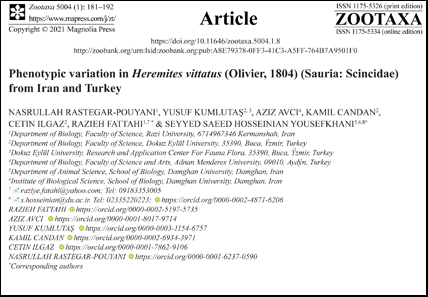Abstract
According to a large morphological dataset of specimens from Turkey to Iran and based on several morphological analyses, the Iranian populations of the skink Heremites vittatus are separated from other populations of this taxon in Turkey. The values of most of morphological characters were higher in the Turkish populations. Morphological variation among populations of H. vittatus (Olivier, 1804) from Turkey and the western slopes of the Zagros Mountains in Kermanshah province in Iran may be the result of different dispersal and vicariance events. Comparison the current study dataset with specimens from Egypt can definite the taxonomic status of Iranian and Turkish populations.
References
Anderson, S.C. (1999) The lizards of Iran. Society for the Study of Amphibians and Reptiles. Contributions to Herpetology, 15, 1–493.
Ashlock, P.D. & Mayr, E. (1991) Principles of systematic zoology. McGraw-Hill, New York, New York, xi + 428 pp.
Bahmani, Z., Rastegar-Pouyani, E. & Rastegar-Pouyani, N. (2018) The phylogenetic relationships and molecular systematics of scincid lizards of the genus Heremites (Sauria, Scincidae) in the Middle East based on mtDNA sequences. Mitochondrial DNA, Part A, 29, 846–855. https://doi.org/10.1080/24701394.2017.1373107
Baran, I. & Atatür, M.K. (1998) The herpetofauna of Turkey (amphibians and reptiles). Republic of Turkey, Ministry of the Environment, Ankara, 214 pp.
Baran, Ý. (1977) Türkiye’de Scincidae familyasý türlerinin taksonomisi [Taxonomy of the Scincidae species in Turkey]. Vol. 1. Doða Bilim Dergisi, Ankara, pp. 217–223.
Baran, Ý., Avcý, A., Kumlutaþ, Y. & Olgun, K. & Ilgaz, Ç. (2021) Türkiye Amfibi ve Sürüngenleri.Palme Yayýnevi, Ankara, 230 pp.
Budak, A. (1973) Türkiye’de Mabuya vittata (Scincidae, Lacertilia)‘nýn bireysel ve coðrafik variasyonu üzerinde çalýþmalar [Studies on individual and geographic variation of Mabuya vittata (Scincidae, Lacertilia) in Turkey]. Ege Üniv Fen Fakültesi Ýlmi Raporlar Serisi, 162, 1–25.
Fathinia, B., Anderson, S.C., Rastegar-Pouyani, N., Jahani, H. & Mohamadi, H. (2009) Notes on the natural history of Pseudocerastes urarachnoides (Squamata: Viperidae). Russýan Journal of Herpetology, 16, 134–138.
Fattahi, R., Ficetola, G.F., Rastegar-Pouyani, N., Avcý, A., Kumlutaþ, Y., Ilgaz, Ç. & Hosseinian Yousefkhani, S.S. (2014) Modelling the potential distribution of the Bridled Skink, Trachylepis vittata (Olivier, 1804), in the Middle East. Zoology in the Middle East, 60, 208–216. https://doi.org/10.1080/09397140.2014.944428
Fattahi, R., Yousefkhani, S.S.H., Ilgaz, C., Kumlutas, Y., Avcý, A. & Rastegar-Pouyani, N. (2013) Distribution of Trachylepis vittata (Olivier, 1804) in Middle East and North Africa. WebPub, 1, 55–57.
Greer, A.E. (1970) The relationships of the skinks referred to the genus Dasia. Breviora, 348, 1–30.
Güçlü, Ö., Candan, K., Kankiliç, T., Kumlutaþ, Y., Durmuþ, S. H., Poulakakis, N. & Ilgaz, Ç. (2014) Phylogeny of Trachylepis sp.(Reptilia) from Turkey inferred from mtDNA sequences. Mitochondrial DNA, 25, 456–463. https://doi.org/10.3109/19401736.2013.814108
Karin, B.R., Metallinou, M., Weinell, J.L., Jackman, T.R. & Bauer, A.M. (2016) Resolving the higher-order phylogenetic relationships of the circumtropical Mabuya group (Squamata: Scincidae): an out-of-Asia diversification. Molecular Phylogenetics and Evolution, 102, 220–232. https://doi.org/10.1016/j.ympev.2016.05.033
Kumlutaþ, Y., Candan, K. & Ilgaz, Ç. (2015) A new -locality record of Trachylepis vittata (Olivier, 1804) (Reptilia: Scincidae) in Northeastern Anatolia, Turkey. Russýan Journal of Herpetology, 22, 310–314.
Leviton, A.E., Anderson, S.C., Adler, K. & Minton, S.A. (1992) Handbook to Middle East amphibians and reptiles. Society for the Study of Amphibians and Reptiles, Oxford Ohio, 252 pp.
Mausfeld, P. & Schmitz, A. (2003) Molecular phylogeography, intraspecific variation and speciation of the Asian scincid lizard genus Eutropis Fitzinger, 1843 (Squamata: Reptilia: Scincidae): taxonomic and biogeographic implications. Organisms Diversity & Evolution, 3, 161–171. https://doi.org/10.1078/1439-6092-00068
Mausfeld, P., Schmitz, A., Böhme, W., Misof, B., Vrcibradic, D. & Rocha, C.F.D. (2002) Phylogenetic affinities of Mabuya atlantica Schmidt, 1945, endemic to the Atlantic Ocean archipelago of Fernando de Noronha (Brazil): necessity of partitioning the genus Mabuya Fitzinger, 1826 (Scincidae: Lygosominae). Zoologischer Anzeiger, 241, 281–293. https://doi.org/10.1078/0044-5231-00081
Mayr, E. (1963) Animal species and evolution. Animal species and evolution. The Belknap Press of Harvard University Press, Cambridge, Cambridge, xvi + 797 pp. https://doi.org/10.4159/harvard.9780674865327
Mulder, J. (1995) Herpetological observations in Turkey (1987–1995). Deinsea, 2, 51–66.
Özdemir, M., Açkurt, F., Kaplan, M., Yýldýz, M., Löker, M., Gürcan, T. & Seyhan, F.G. (2001) Evaluation of new Turkish hybrid hazelnut (Corylus avellana L.) varieties: fatty acid composition, α-tocopherol content, mineral composition and stability. Food Chemistry, 73, 411–415. https://doi.org/10.1016/S0308-8146(00)00315-0
Özdemir, A., Durmuþ, S.H., Kete, R. & Yýlmaz, Ý. (2001) Hatay ve Gaziantep Mabuya vittata Olivier 1804 (Lacertilia: Scincidae) Örnekleri Üzerinde Bir Araþtýrma [A research on Mabuya vittata Olivier 184 (Lacertilia: Scincidae) specimens from Hatay and Gaziantep]. Anadolu Üniversitesi Bilim ve Teknoloji Dergisi, 2, 271–275.
Sindaco, R., Metallinou, M., Pupin, F., Fasola, M. & Carranza, S. (2012) Forgotten in the ocean: systematics, biogeography and evolution of the Trachylepis skinks of the Socotra Archipelago. Zoologica Scripta, 41, 346–362. https://doi.org/10.1111/j.1463-6409.2012.00540.x
Šmíd, J., Moravec, J., Kodym, P., Kratochvíl, L., Hosseinian Yousefkhani, S.S. & Frynta, D. (2014) Annotated checklist and distribution of the lizards of Iran. Zootaxa, 3855 (1), 1–97. https://doi.org/10.11646/zootaxa.3855.1.1
Uetz, P. (2018) The Reptile database, Internet references. Available from: http://www.reptile-database.org/ (accessed 10 November 2018)
Uetz, P., Cherikh, S., Shea, G., Ineich, I., Campbell, P.D., Doronin, I.V., Rosado, J., Wynn, A., Tighe, K.A., Mcdiarmid, R., Lee, J.L., Köhler, G., Ellis, R., Doughty, P., Raxworthy, C.J., Scheinberg, L., Resetar, A., Sabaj, M., Schneider, G., Franzen, M., Glaw, F., Böhme, W., Schweiger, S., Gemel, R., Couper, P., Amey, A., Dondorp, E., Ofer, G., Meiri , S. & Wallach, V. (2019) A global catalog of primary reptile type specimens. Zootaxa, 4695 (5), 438–450. https://doi.org/10.11646/zootaxa.4695.5.2
Vita-Finzi, C. (2001) Neotectonics at the Arabian plate margins. Journal of Structur Geology, 23, 521–530. https://doi.org/10.1016/S0191-8141(00)00117-6
Werner, F. (1898) Über einige neuen Reptilian und einige neuen Frousch aus dem cilicischen Taurus. Zoologischer Anzeiger, 21, 217–223.
Whiting, A.S., Sites Jr., J.W., Pellegrino, K.C. & Rodrigues, M.T. (2006) Comparing alignment methods for inferring the history of the new world lizard genus Mabuya (Squamata: Scincidae). Molecular Phylogenetics and Evolution, 38, 719–730. https://doi.org/10.1016/j.ympev.2005.11.011


